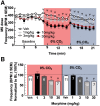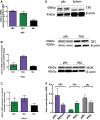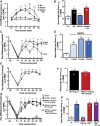Cannabinoid-2 Agonism with AM2301 Mitigates Morphine-Induced Respiratory Depression
- PMID: 33998869
- PMCID: PMC8612410
- DOI: 10.1089/can.2020.0076
Cannabinoid-2 Agonism with AM2301 Mitigates Morphine-Induced Respiratory Depression
Abstract
Introduction: An escalating number of fatalities resulting from accidental opioid overdoses typically attributed to respiratory depression continue to define the opioid epidemic. Opioid respiratory depression results from a decrease in reflexive inspiration within the preBötzinger complex in the brainstem. Objective: Cannabinoid receptor agonism is reported to enhance opioid analgesia, yet whether cannabinoids enhance or inhibit opioid-induced respiratory depression is unknown. Methods: Studies herein sought to define the roles of cannabinoid-1 receptor (CB1R) and cannabinoid-2 receptor (CB2R) on respiratory depression using selective agonists alone and in combination with morphine in male mice. Results: Using whole body plethysmography, the nonselective CB1R and CB2R agonist (Δ9-tetrahydrocannabinol) and the CB1R synthetic cannabinoid, AM356, induced respiratory depression, whereas the well-published selective CB2 agonist, JWH 133, and the novel CB2 agonist (AM2301) did not. Moreover, a selective CB2R agonist (AM2301) significantly attenuated morphine sulfate-induced respiratory depression. Conclusion: Notably, findings suggest that attenuation of opioid-induced respiratory depression relies on CB2R activation, supporting selective CB2R agonism as an opioid adjunct therapy.
Keywords: cannabinoid receptor 1; cannabinoid receptor 2; mu opioid receptor; opioid-induced respiratory depression; preBötzinger complex.
Conflict of interest statement
The authors declare no competing financial interests.
Figures






Similar articles
-
Brain Penetrant, but not Peripherally Restricted, Synthetic Cannabinoid 1 Receptor Agonists Promote Morphine-Mediated Respiratory Depression.Cannabis Cannabinoid Res. 2022 Oct;7(5):621-627. doi: 10.1089/can.2021.0090. Epub 2021 Dec 17. Cannabis Cannabinoid Res. 2022. PMID: 34935460 Free PMC article.
-
Cannabinoid 1 and mu-Opioid Receptor Agonists Synergistically Inhibit Abdominal Pain and Lack Side Effects in Mice.J Neurosci. 2022 Aug 17;42(33):6313-6324. doi: 10.1523/JNEUROSCI.0641-22.2022. Epub 2022 Jul 5. J Neurosci. 2022. PMID: 35790401 Free PMC article.
-
Cannabinoid CB2 Receptor Activation Attenuates Fentanyl-Induced Respiratory Depression.Cannabis Cannabinoid Res. 2021 Oct;6(5):389-400. doi: 10.1089/can.2020.0059. Epub 2020 Oct 21. Cannabis Cannabinoid Res. 2021. PMID: 33998863 Free PMC article.
-
Cannabinoids in pain management: CB1, CB2 and non-classic receptor ligands.Expert Opin Investig Drugs. 2014 Aug;23(8):1123-40. doi: 10.1517/13543784.2014.918603. Epub 2014 May 16. Expert Opin Investig Drugs. 2014. PMID: 24836296 Review.
-
Revealing the therapeutic potential of synthetic cannabinoids: a systematic review of cannabinoid receptor binding dynamics and their implications for cancer therapy.J Cannabis Res. 2025 Jun 7;7(1):33. doi: 10.1186/s42238-025-00289-5. J Cannabis Res. 2025. PMID: 40483537 Free PMC article. Review.
Cited by
-
Simultaneous fatal poisoning of two victims with 4F-MDMB-BINACA and ethanol.Forensic Toxicol. 2023 Jan;41(1):151-157. doi: 10.1007/s11419-022-00632-y. Epub 2022 Jun 28. Forensic Toxicol. 2023. PMID: 36652056 Free PMC article.
-
The endocannabinoid system and breathing.Front Neurosci. 2023 Apr 18;17:1126004. doi: 10.3389/fnins.2023.1126004. eCollection 2023. Front Neurosci. 2023. PMID: 37144090 Free PMC article. Review.
-
CB1 cannabinoid receptor agonists induce acute respiratory depression in awake mice.Pharmacol Res. 2025 Apr;214:107682. doi: 10.1016/j.phrs.2025.107682. Epub 2025 Mar 8. Pharmacol Res. 2025. PMID: 40064359 Free PMC article.
-
Δ9-Tetrahydrocannabinol Effects on Respiration and Heart Rate Across Route of Administration in Female and Male Mice.Cardiovasc Toxicol. 2023 Dec;23(11-12):349-363. doi: 10.1007/s12012-023-09810-9. Epub 2023 Sep 20. Cardiovasc Toxicol. 2023. PMID: 37728714 Free PMC article.
-
History of Respiratory Stimulants.J Pain Res. 2021 Apr 16;14:1043-1049. doi: 10.2147/JPR.S298607. eCollection 2021. J Pain Res. 2021. PMID: 33889020 Free PMC article. Review.
References
-
- NASEM. Pain management and the opioid epidemic: balancing societal and individual benefits and risks of prescription opioid use. The National Academies Press: Washington, DC, 2017. - PubMed
-
- Markos JR, Harris HM, Gul W, ElSohly MA, Sufka KJ. Effects of cannabidiol on morphine conditioned place preference in mice. Planta Medica. 2018;84:221–224. - PubMed
-
- Control CfD, Prevention. Understanding the epidemic. 2017;11. Available at https://www.cdc.gov/drugoverdose/epidemic/index.html Accessed October 15, 2020.
-
- Dahan A, Aarts L, Smith TW. Incidence, reversal, and prevention of opioid-induced respiratory depression. Anesthesiology. 2010;112:226–238. - PubMed
Publication types
MeSH terms
Substances
Grants and funding
LinkOut - more resources
Full Text Sources
Medical
Research Materials

